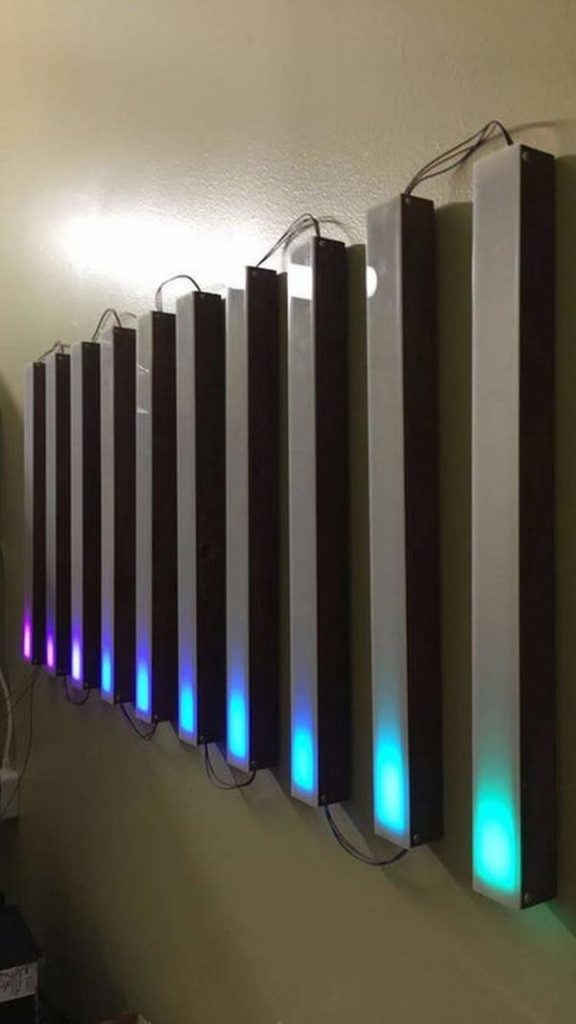
In this post, we will talk about Retro-LED-Strip-Audio-Visualizer: As a musician and electrical engineering student, I love any project that intersects these two fields.
I’ve seen some DIY audio visualizers (here, here, here, and here), but each had missed at least one of the two goals I established for myself: professional build quality and a relatively large display (a wimpy 8*8 LED matrix would not suffice here!). With some vintage flair, and sitting at 40″ x 20″, this audio visualizer accomplishes both of those goals. Apologies in advance for vertical photos. A lot of them were taken for social media.
Retro LED Strip Audio Visualizer:
Step 1: Parts List
I had several of these parts lying around already. The links are purely for reference. Please don’t buy unnecessarily expensive components.
Electronics
- WS2811 60LEDS/m @ 5m, IP30 (Non-Waterproof), Addressable – These were cheaper then WS2812 at the time. You have some leeway here but make sure the dimensions are correct and that you can actually talk to the LEDs. Also, note that WS2811s are 12V while WS2812s are 5V.
- 9 x 3-Pin JST Connectors + Receptacles
- DC 12V 20A (240W) Power Supply – I initially planned on doing 2 LED strips, and wanted a blow-your-house-down speaker set. Each light strip is 90W in a worst-case scenario (I haven’t measured to confirm), which left me ~60W for speakers + amplifier. The 15A option was only $4 less anyway.
- Power cord (3 Prong)
- Arduino Uno – I had an R3 lying around so I used that. You may be able to find a cheaper option from one of the knockoffs or another vendor.
- TRRS Breakout – For aux input
- L7805 5V Regulator – Any 5V regulator that accepts a 12V input will work.
- 330 nF, 100 nF capacitors – per L7805 datasheet
- 2 x 10kR, 2 x 1kR, 2 x 100 nF capacitors – for audio input biasing
- Stereo Receiver – any vintage stereo receiver will work as long as it has aux input (3.5mm or RCA). I picked up a Panasonic RA6600 off craigslist for $15. I recommend checking Goodwill, Craigslist, and other thrift stores for similar.*
- Speakers – Not BT speakers. Just a speaker set. Pay attention to what impedance is compatible with your receiver. I found a set of 3 20W (=loud) speakers at Goodwill for $6, and that came with a “center” and two “front” speakers.
- Logitech BT Audio Adapter – this device can stream audio out to the stereo speakers and to your circuit
- RCA male to RCA male cable
- Aux cord
Hardware:
- 2×6 (8ft) – Not pressure treated. Should be ~$6 or less at HD or Lowe’s
- 40% Light Transmission Acrylic – I ordered 18″ x 24″ x 1/8″, and it was technically 17.75″ x 23.5″. Keep it in the wrapping when you go to laser cut.
- Wood Stain – You only need a small can. I used Minwax red mahogany and it came out very nice. I definitely recommend a dark tone. I originally tried provincial and it didn’t look as nice.
- Lacquer – First off, check out this video by Steve Ramsey and decide for yourself what works best. I got a spray can of semi-gloss (no gloss was available) and honestly, it didn’t do that much. But I also only did one coat due to time constraints.
- 40 x 1/2″ Wood screws – I had round head available to me but I recommend using flat top if you can. I don’t think that would interfere with the build quality but feel free to ask anyone more familiar with woodworking first.
- Scrap wood, gorilla glue, hot glue, solder, wire, and command strips (velcro style, 20 medium or 10 large)
* I plan on building a soundbar to make this project entirely “from scratch,” which will replace 9-13 above. I hope to update this instructable with that by the end of the summer.
Step 2: Prototyping
This section is not something you need to complete, but I do want to show what the project looked like as it went along.
Here, I taped down LEDs in the snake pattern and was experimenting with light diffusion via trash bag layered over top of itself (I highly recommend that as an alternative to the acrylic if you are trying to cut costs. Though you’ll have to attach it some different way).
A 10×10 setup worked for me, but you may prefer 8×12 or 7×14. Feel free to experiment. Before I had my stereo, I found an amplifier and hooked it up in my breadboard, and before that, I played audio from my laptop to the circuit for audio analysis and simultaneously hit “play” on my phone to hear it.
I’m a huge believer in measure twice, cut once. So whatever you do, follow that guide and you’ll be set.
Read Full Post